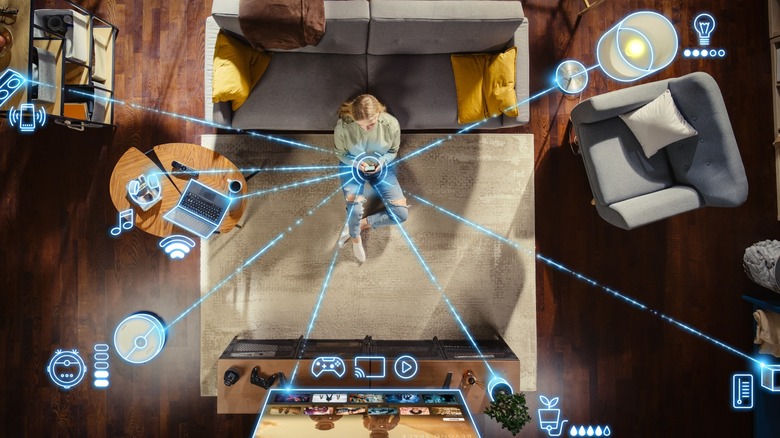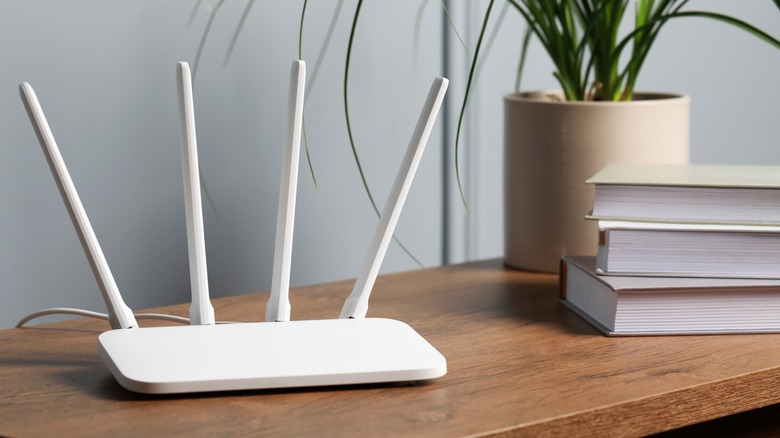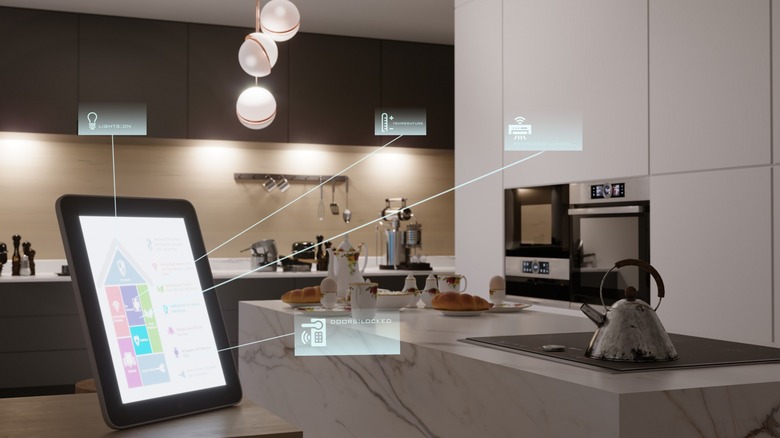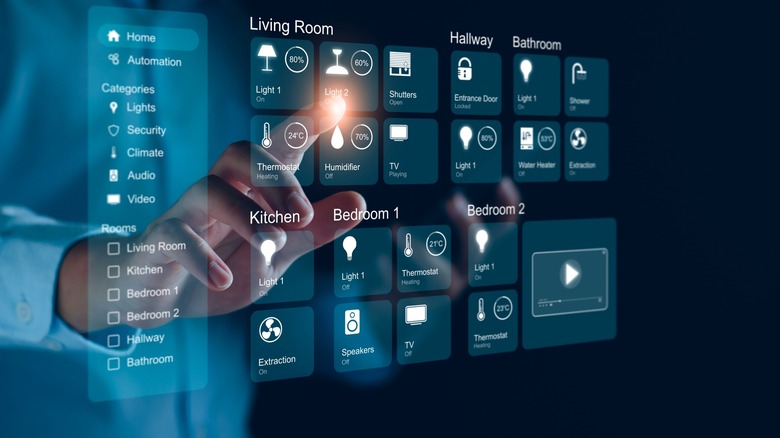Mistakes You're Bound To Make As A Smart Home Owner
It can be easy to get caught up in the smart home craze. Voice-controlled light bulbs, scenes that ensure you're returning to a comfortable house no matter the season, deadbolts that can be locked from across the world — it's an addicting slew of possibilities. You need to ask yourself, "How much of it is necessary?"
As you start your journey into smart home ownership, you should take a step back to get a big-picture overview. There are numerous ways you can make your home a smart home, and there are just as many mistakes you can make as you set it up to be interconnected and digitized.
Before you set out to buy every smart device available, consider your actual needs and whether you're being too ambitious. What does that mean, exactly? Well, we'll discuss that more below as we explore common mistakes made by new smart homeowners.
Pay close attention now to avoid headaches and more money spent in the future.
Inadequate Wi-Fi
Inadequate Wi-Fi? What does it mean if Wi-Fi is a constantly running signal with no physical form to degrade? As you'll quickly find with the more devices you add to your network, Wi-Fi is not an infinite resource. In fact, every Wi-Fi signal has a maximum bandwidth or the maximum amount of data it can transmit (represented as Mbps). Every device on your network requires a certain amount of bandwidth to work, so the more devices connected to your Wi-Fi, the more your bandwidth is spread thin.
When you look at the specs of your Wi-Fi router, whether you purchased it independently or are using your internet service provider's model, you'll see how many devices it says it can manage. The number is usually in the hundreds, but there are two things to consider with that number:
- You'll accumulate devices quickly.
- It's a very rough estimate based on optimal settings.
- The router's capacity doesn't speak to your Wi-Fi signal's strength.
In general, smart home devices don't use a ton of bandwidth. It's your phones, laptops, gaming consoles, and streaming services that get in the way. When deciding on an internet package, consider how many devices you'll have on your network. There's no such thing as a signal that is too strong, so it's best to overestimate if it's within budget.
To make your home smart, we'd recommend starting with a 500 Mbps plan and increasing from there if necessary.
Going all-in at one time
It can be easy to get sucked into the allure of a fully automated home. Do you need to get every device all at once though? Not necessarily. Before shopping, think about ways you want to automate your home and start weeding out the extraneous devices.
Start with more essential devices that simplify life and add value. For example, a smart thermostat can help reduce your electric bill, while smart smoke and CO detectors add an extra layer of safety. Smart plugs, blinds, deadbolts, and doorbells are worthwhile considerations, as they maximize your home's efficiency or security.
If you invest in many different devices from the jump, you risk not learning their nuances. It takes time to understand each device and its use to maximize potential. Instruction manuals only speak in generalizations. The more you use your smart devices, the more you may find functions that better serve your needs and wants.
You're also more likely to overload your Wi-Fi, forcing you to spend more on a higher plan when the alternative could have been skipping out on devices you didn't necessarily need.
Setting and forgetting
While smart home automation can be passive and run in the background of your life, some devices require your input to be fully functional. For example, without you changing the color, an RGB LED bulb is essentially just a costlier light bulb.
A big mistake many smart home users will make is buying devices and doing nothing with them. Or, at the very least, using them to their minimum potential. Consider something like an Amazon Echo, which was found to be underutilized. According to Amazon, only 56% of Echo Dot owners use their devices — most only for music, timers, or light control.
Part of the issue is not knowing a device and its capabilities. This is more likely to happen when you overload yourself on devices and don't properly plan your smart home ecosystem. When developing your smart home, decide what you want out of it and shop accordingly.
Not keeping devices up to date
One reason you may have made the switch to a smart home is for added security. Doorbells, cameras, and even lighting can do wonders to keep your home safe. That is, so long as they're up to date. A device is at its most secure when a firmware update is released. Why? Because updates typically address current threats and vulnerabilities and add fixes or protections to your devices.
If you don't update your devices regularly, you're missing new features. Maybe there's a new integration you could take advantage of, or the new firmware fixes a bug present in the previous build. There are several reasons why companies update their devices, and for the most part, they're all user-friendly.
If you're ever concerned about what an update entails, check the manufacturer's website. They often publicly release patch notes that detail every change. For smart devices, there's little reason not to turn on automatic updates to ensure you're the most secure.
Overly-complicating your smart home
Do you want a security system that watches over your home while you're away? Get a doorbell camera and several perimeter cameras. Are you looking to perfect the ambient lighting in your home? Grab a few smart bulbs and call it a day. If you want to simplify tasks around the house like vacuuming, buy a smart vacuum.
Don't overthink things by buying what you don't need, and don't get caught up in the never-ending catalog of devices. Smart fridges, for example, may be completely unnecessary, offering no real benefit to your home save for a big screen that can break and get dirty. Even small appliances, like a smart toaster, don't necessarily add value to your life, and smart home integration should have inherent value.
Stick to the basics and only add what you need. This will prevent overspending and an unwieldy smart ecosystem with devices that are easy to forget.





